Showing Spotlights 529 - 536 of 624 in category All (newest first):
 Nanotechnology will play an important role in future space missions. Nanosensors, dramatically improved high-performance materials, or highly efficient propulsion systems are but a few examples. In previous Nanowerk Spotlights we reported about nanotechnology propulsion technology, such as nano field emission thrusters, and the use of carbon nanotubes to harden electronic components in space. This last aspect, radiation shielding, is also where nanotechnology could make a major contribution to human space flight. NASA says that the risks of exposure to space radiation are the most significant factor limiting humans�?? ability to participate in long-duration space missions. A lot of research therefore focuses on developing countermeasures to protect astronauts from those risks. To meet the needs for radiation protection as well as other requirements such as low weight and structural stability, spacecraft designers are looking for materials that help them develop multifunctional spacecraft hulls. Advanced nanomaterials such as the newly developed, isotopically enriched boron nanotubes could pave the path to future spacecraft with nanosensor-integrated hulls that provide effective radiation shielding as well as energy storage.
Nanotechnology will play an important role in future space missions. Nanosensors, dramatically improved high-performance materials, or highly efficient propulsion systems are but a few examples. In previous Nanowerk Spotlights we reported about nanotechnology propulsion technology, such as nano field emission thrusters, and the use of carbon nanotubes to harden electronic components in space. This last aspect, radiation shielding, is also where nanotechnology could make a major contribution to human space flight. NASA says that the risks of exposure to space radiation are the most significant factor limiting humans�?? ability to participate in long-duration space missions. A lot of research therefore focuses on developing countermeasures to protect astronauts from those risks. To meet the needs for radiation protection as well as other requirements such as low weight and structural stability, spacecraft designers are looking for materials that help them develop multifunctional spacecraft hulls. Advanced nanomaterials such as the newly developed, isotopically enriched boron nanotubes could pave the path to future spacecraft with nanosensor-integrated hulls that provide effective radiation shielding as well as energy storage.
Jun 29th, 2007
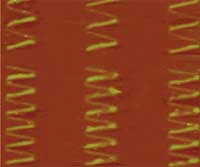 Nanoimprinting lithography (NIL) is a simple pattern transfer process that is emerging as an alternative nanopatterning technology to traditional photolithography. NIL allows the fabrication of two-dimensional or three-dimensional structures with submicrometer resolution and the patterning and modification of functional materials. A key benefit of nanoimprint lithography is its sheer simplicity. There is no need for complex optics or high-energy radiation sources with a nanoimprint tool. There is no need for finely tailored photoresists designed for both resolution and sensitivity at a given wavelength. The simplified requirements of the technology allow low-cost, high-throughput production processes of various nanostructures with operational ease. NIL already has been applied in various fields such as biological nanodevices, nanophotonic devices, organic electronics, and the patterning of magnetic materials. Researchers at Berkeley have taken this process one step further by demonstrating that direct nanoimprinting of metal nanoparticles enables low temperature metal deposition as well as high-resolution patterning. This approach has substantial potential to take advantage of nanoimprinting for the application in ultralow cost, large area printed electronics.
Nanoimprinting lithography (NIL) is a simple pattern transfer process that is emerging as an alternative nanopatterning technology to traditional photolithography. NIL allows the fabrication of two-dimensional or three-dimensional structures with submicrometer resolution and the patterning and modification of functional materials. A key benefit of nanoimprint lithography is its sheer simplicity. There is no need for complex optics or high-energy radiation sources with a nanoimprint tool. There is no need for finely tailored photoresists designed for both resolution and sensitivity at a given wavelength. The simplified requirements of the technology allow low-cost, high-throughput production processes of various nanostructures with operational ease. NIL already has been applied in various fields such as biological nanodevices, nanophotonic devices, organic electronics, and the patterning of magnetic materials. Researchers at Berkeley have taken this process one step further by demonstrating that direct nanoimprinting of metal nanoparticles enables low temperature metal deposition as well as high-resolution patterning. This approach has substantial potential to take advantage of nanoimprinting for the application in ultralow cost, large area printed electronics.
Jun 27th, 2007
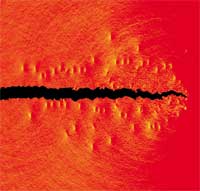 Bone is one of the most fascinating materials that has evolved in nature. There are 206 bones in your body - did you know that a newborn has 350 bones but they fuse together as you grow? - more than half of them in your hands and feet. These bones not only protect your organs, support your body against gravity's pull and allow you to move but they also are living tissues that produce blood cells and store important minerals. Not only important for humans, bones are the essential part of the endoskeleton of all vertebrates. Bone is a composite material of the mineral calcium hydroxyapatite and tropocollagen molecules (the fragile and soluble form of collagen when first synthesized by fibroblasts). It forms an extremely tough, yet lightweight material and its properties and behavior are of great interest to scientists and materials engineers. For instance, very little is known about the fracture behavior of bone and all such studies have been conducted at scales much larger than the nanoscale that explicitly considers individual tropocollagen molecules and mineral particles. New research at MIT has discovered a previously unknown toughening mechanism of bone that operates at the nanoscale - the level of individual collagen molecules and nano-platelets of hydroxyapatite. This breakthrough work lays the foundation for new materials design that includes the nanostructure as a specific 'design variable' and may help engineers to design materials from the bottom up by including hierarchies as a design parameter.
Bone is one of the most fascinating materials that has evolved in nature. There are 206 bones in your body - did you know that a newborn has 350 bones but they fuse together as you grow? - more than half of them in your hands and feet. These bones not only protect your organs, support your body against gravity's pull and allow you to move but they also are living tissues that produce blood cells and store important minerals. Not only important for humans, bones are the essential part of the endoskeleton of all vertebrates. Bone is a composite material of the mineral calcium hydroxyapatite and tropocollagen molecules (the fragile and soluble form of collagen when first synthesized by fibroblasts). It forms an extremely tough, yet lightweight material and its properties and behavior are of great interest to scientists and materials engineers. For instance, very little is known about the fracture behavior of bone and all such studies have been conducted at scales much larger than the nanoscale that explicitly considers individual tropocollagen molecules and mineral particles. New research at MIT has discovered a previously unknown toughening mechanism of bone that operates at the nanoscale - the level of individual collagen molecules and nano-platelets of hydroxyapatite. This breakthrough work lays the foundation for new materials design that includes the nanostructure as a specific 'design variable' and may help engineers to design materials from the bottom up by including hierarchies as a design parameter.
Jun 26th, 2007
 A lot of buzz has been created by the term "green nanotechnology". In a broad sense, this term includes a wide range of possible applications, from nanotechnology-enabled, environmentally friendly manufacturing processes that reduce waste products (ultimately leading to atomically precise molecular manufacturing with zero waste); the use of nanomaterials as catalysts for greater efficiency in current manufacturing processes by minimizing or eliminating the use of toxic materials (green chemistry principles); the use of nanomaterials and nanodevices to reduce pollution (e.g. water and air filters); and the use of nanomaterials for more efficient alternative energy production (e.g. solar and fuel cells). Unfortunately, there is a flip side to these benefits. As scientists experiment with the development of new chemical or physical methods to produce nanomaterials, the concern for a negative impact on the environment is also heightened: some of the chemical procedures involved in the synthesis of nanomaterials use toxic solvents, could potentially generate hazardous byproducts, and often involve high energy consumption (not to mention the unsolved issue of the potential toxicity of certain nanomaterials). This is leading to a growing awareness of the need to develop clean, nontoxic and environmentally friendly procedures for synthesis and assembly of nanoparticles. Scientists are now exploring the use of biological organisms to literally grow nanomaterials.
A lot of buzz has been created by the term "green nanotechnology". In a broad sense, this term includes a wide range of possible applications, from nanotechnology-enabled, environmentally friendly manufacturing processes that reduce waste products (ultimately leading to atomically precise molecular manufacturing with zero waste); the use of nanomaterials as catalysts for greater efficiency in current manufacturing processes by minimizing or eliminating the use of toxic materials (green chemistry principles); the use of nanomaterials and nanodevices to reduce pollution (e.g. water and air filters); and the use of nanomaterials for more efficient alternative energy production (e.g. solar and fuel cells). Unfortunately, there is a flip side to these benefits. As scientists experiment with the development of new chemical or physical methods to produce nanomaterials, the concern for a negative impact on the environment is also heightened: some of the chemical procedures involved in the synthesis of nanomaterials use toxic solvents, could potentially generate hazardous byproducts, and often involve high energy consumption (not to mention the unsolved issue of the potential toxicity of certain nanomaterials). This is leading to a growing awareness of the need to develop clean, nontoxic and environmentally friendly procedures for synthesis and assembly of nanoparticles. Scientists are now exploring the use of biological organisms to literally grow nanomaterials.
Jun 21st, 2007
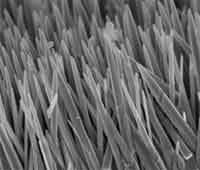 Large-scale and high-density semiconductor arrays with one-dimensional ("1D" - where one dimension of the structure is nanoscale) nanostructures have been extensively studied for their potential application in future electrooptical devices. Among them, zinc oxide (ZnO) is considered to be very attractive for high-efficiency short-wavelength optoelectronic nanodevices because of its large exciton binding energy of 60 meV and high mechanical and thermal stabilities. ZnO nanorod/ nanowire arrays have also been demonstrated to be highly versatile and proven to be quite effective in piezoelectric nanogenerators, dye-sensitized solar cells, photonic crystals, superhydrophobic surfaces, and even biodevices due to their biocompatibility. One of the issues researchers are still grappling with is the synthesis of ZnO nanowire arrays. On one hand, high-temperature techniques such as chemical vapor deposition (CVD) have been widely employed and result in high quality nanostructures. However, these methods are energy-consuming and expensive. On the other hand, there are several advantages of growing semiconducting nanostructures directly on conducting metal substrates, for instance the formation of robust electrical contacts during the growth. Such wet chemical methods, which are appealing for their low temperature, facile manipulation, and potential for scale-up have recently been developed for the production of aligned ZnO nanostructures and so far the most successful route has been seeded growth on ZnO-nanoparticle-coated substrates. In these two-step processes the coating of the substrate for the formation of a nucleation layer remains complex and difficult/irreproducible. Therefore, large-scale, low-cost controllable growth of well-aligned ZnO 1D nanostructures on properly fitting substrates via a one-step synthetic approach is still crucially needed for novel applications to become practicable. Researchers in China now have demonstrated exactly such a highly effective solution by growing well-aligned ZnO 1D nanostructures on various inert metal substrates at low temperature on a large scale.
Large-scale and high-density semiconductor arrays with one-dimensional ("1D" - where one dimension of the structure is nanoscale) nanostructures have been extensively studied for their potential application in future electrooptical devices. Among them, zinc oxide (ZnO) is considered to be very attractive for high-efficiency short-wavelength optoelectronic nanodevices because of its large exciton binding energy of 60 meV and high mechanical and thermal stabilities. ZnO nanorod/ nanowire arrays have also been demonstrated to be highly versatile and proven to be quite effective in piezoelectric nanogenerators, dye-sensitized solar cells, photonic crystals, superhydrophobic surfaces, and even biodevices due to their biocompatibility. One of the issues researchers are still grappling with is the synthesis of ZnO nanowire arrays. On one hand, high-temperature techniques such as chemical vapor deposition (CVD) have been widely employed and result in high quality nanostructures. However, these methods are energy-consuming and expensive. On the other hand, there are several advantages of growing semiconducting nanostructures directly on conducting metal substrates, for instance the formation of robust electrical contacts during the growth. Such wet chemical methods, which are appealing for their low temperature, facile manipulation, and potential for scale-up have recently been developed for the production of aligned ZnO nanostructures and so far the most successful route has been seeded growth on ZnO-nanoparticle-coated substrates. In these two-step processes the coating of the substrate for the formation of a nucleation layer remains complex and difficult/irreproducible. Therefore, large-scale, low-cost controllable growth of well-aligned ZnO 1D nanostructures on properly fitting substrates via a one-step synthetic approach is still crucially needed for novel applications to become practicable. Researchers in China now have demonstrated exactly such a highly effective solution by growing well-aligned ZnO 1D nanostructures on various inert metal substrates at low temperature on a large scale.
Jun 18th, 2007
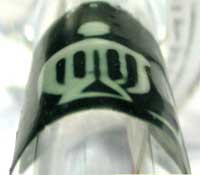 Thin, flexible displays have become an everyday component in many electronic gadgets from cell phones to digital cameras and MP3 players. Most of these displays are based on LCD technology, liquid crystals combined with polymeric structures, and one of their drawbacks is that their manufacturing cost grows rapidly with increasing screen size. A recently developed alternative approach for thin, flexible displays makes use of thermochromic composite thin-films. Thermo- chromism is the ability of a substance to change color due to a change in temperature. This first of a kind thermochromic display is based on films with thermochromic nanoparticles and embedded conductive wiring patterns. Based on the ease of fabrication and simple architecture, thermochromic displays could have advantages in lowering the display unit cost and, due to their heating pulse control scheme, can also lower power consumption compared with conventional displays.
Thin, flexible displays have become an everyday component in many electronic gadgets from cell phones to digital cameras and MP3 players. Most of these displays are based on LCD technology, liquid crystals combined with polymeric structures, and one of their drawbacks is that their manufacturing cost grows rapidly with increasing screen size. A recently developed alternative approach for thin, flexible displays makes use of thermochromic composite thin-films. Thermo- chromism is the ability of a substance to change color due to a change in temperature. This first of a kind thermochromic display is based on films with thermochromic nanoparticles and embedded conductive wiring patterns. Based on the ease of fabrication and simple architecture, thermochromic displays could have advantages in lowering the display unit cost and, due to their heating pulse control scheme, can also lower power consumption compared with conventional displays.
Jun 14th, 2007
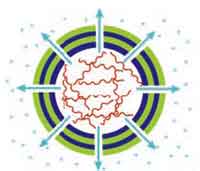 You cut yourself in the finger - and a few days later your skin has completely healed again. Biological organisms have an amazing ability to automatically initiate self-healing and self-repair when they sustain damage. Materials engineers are dreaming about making materials that could do the same thing. Imagine self-repairing cars, planes, bridges or buildings. These materials could be of particular use in structures that are at present impractical or impossible to repair, such as electronic circuit boards, implanted medical devices or spacecraft. Self-repairing materials would have a massive impact on virtually all industries, lengthening product lifetimes, increasing safety, and lowering product costs by reducing maintenance requirements. Thanks to nanotechnology, these visions are coming closer to reality. One approach is the use of nanocontainers that possess the ability to release encapsulated active materials in a controlled way, leading to a new family of self-repairing coatings.
You cut yourself in the finger - and a few days later your skin has completely healed again. Biological organisms have an amazing ability to automatically initiate self-healing and self-repair when they sustain damage. Materials engineers are dreaming about making materials that could do the same thing. Imagine self-repairing cars, planes, bridges or buildings. These materials could be of particular use in structures that are at present impractical or impossible to repair, such as electronic circuit boards, implanted medical devices or spacecraft. Self-repairing materials would have a massive impact on virtually all industries, lengthening product lifetimes, increasing safety, and lowering product costs by reducing maintenance requirements. Thanks to nanotechnology, these visions are coming closer to reality. One approach is the use of nanocontainers that possess the ability to release encapsulated active materials in a controlled way, leading to a new family of self-repairing coatings.
Jun 13th, 2007
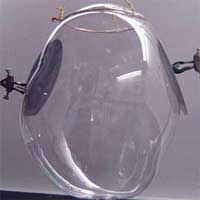 One of the most common methods of film manufacture is Blown Film Extrusion. The process, by which most commodity and specialized plastic films are made for the packaging industry, involves extrusion of a plastic through a circular die, followed by "bubble-like" expansion. The resulting thin tubular film can be used directly, or slit to form a flat film. Nanoscientists now have found a way to use this very common and efficient industrial technology to potentially solve the problem of fabricating large-area nanocomposite films. Currently, the problems with making thin film assemblies are either the production cost of using complex techniques like wet spinning or the unsatisfactory results of unevenly distributed and lumping nanoparticles within the film. The new bubble film technique results in well-aligned and controlled-density nanowire and carbon nanotubes (CNTs) films over large areas. These findings could finally open the door to affordable and reliable large-scale assembly of nanostructures.
One of the most common methods of film manufacture is Blown Film Extrusion. The process, by which most commodity and specialized plastic films are made for the packaging industry, involves extrusion of a plastic through a circular die, followed by "bubble-like" expansion. The resulting thin tubular film can be used directly, or slit to form a flat film. Nanoscientists now have found a way to use this very common and efficient industrial technology to potentially solve the problem of fabricating large-area nanocomposite films. Currently, the problems with making thin film assemblies are either the production cost of using complex techniques like wet spinning or the unsatisfactory results of unevenly distributed and lumping nanoparticles within the film. The new bubble film technique results in well-aligned and controlled-density nanowire and carbon nanotubes (CNTs) films over large areas. These findings could finally open the door to affordable and reliable large-scale assembly of nanostructures.
May 31st, 2007
 Nanotechnology will play an important role in future space missions. Nanosensors, dramatically improved high-performance materials, or highly efficient propulsion systems are but a few examples. In previous Nanowerk Spotlights we reported about nanotechnology propulsion technology, such as nano field emission thrusters, and the use of carbon nanotubes to harden electronic components in space. This last aspect, radiation shielding, is also where nanotechnology could make a major contribution to human space flight. NASA says that the risks of exposure to space radiation are the most significant factor limiting humans�?? ability to participate in long-duration space missions. A lot of research therefore focuses on developing countermeasures to protect astronauts from those risks. To meet the needs for radiation protection as well as other requirements such as low weight and structural stability, spacecraft designers are looking for materials that help them develop multifunctional spacecraft hulls. Advanced nanomaterials such as the newly developed, isotopically enriched boron nanotubes could pave the path to future spacecraft with nanosensor-integrated hulls that provide effective radiation shielding as well as energy storage.
Nanotechnology will play an important role in future space missions. Nanosensors, dramatically improved high-performance materials, or highly efficient propulsion systems are but a few examples. In previous Nanowerk Spotlights we reported about nanotechnology propulsion technology, such as nano field emission thrusters, and the use of carbon nanotubes to harden electronic components in space. This last aspect, radiation shielding, is also where nanotechnology could make a major contribution to human space flight. NASA says that the risks of exposure to space radiation are the most significant factor limiting humans�?? ability to participate in long-duration space missions. A lot of research therefore focuses on developing countermeasures to protect astronauts from those risks. To meet the needs for radiation protection as well as other requirements such as low weight and structural stability, spacecraft designers are looking for materials that help them develop multifunctional spacecraft hulls. Advanced nanomaterials such as the newly developed, isotopically enriched boron nanotubes could pave the path to future spacecraft with nanosensor-integrated hulls that provide effective radiation shielding as well as energy storage.
 Subscribe to our Nanotechnology Spotlight feed
Subscribe to our Nanotechnology Spotlight feed





